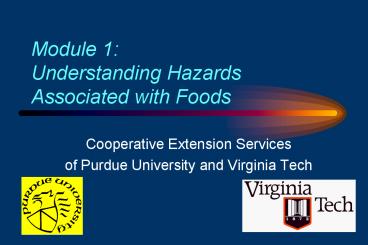Module 1: Understanding Hazards Associated with Foods - PowerPoint PPT Presentation
1 / 20
Title:
Module 1: Understanding Hazards Associated with Foods
Description:
Hepatitis A virus (strawberries) Examples of. Biological Hazards $5,000 Cash or ... Holding at low temperatures ( 40oF) prevents microbes from growing ... – PowerPoint PPT presentation
Number of Views:116
Avg rating:3.0/5.0
Title: Module 1: Understanding Hazards Associated with Foods
1
Module 1 Understanding Hazards Associated with
Foods
- Cooperative Extension Services
- of Purdue University and Virginia Tech
2
Food Safety and Food Quality
- Food Safety making a food safe to eat free of
disease causing agents - Food Quality making a food desirable to eat
good taste, color, and texture
3
Unacceptable Foods
- Poor Quality Unsafe
- bad color too many bacteria
- wrong texture toxic chemicals
- smells bad foreign objects
4
What are the Hazards in our Food?
- Biological bacteria, viruses, parasites
- Chemical sanitizers, pesticides, antibiotics
- Physical bone, rocks, metal
5
How Do Foods Become Contaminated?
6
Controlling the Hazards
- Time and Temperature
- Separation
7
Biological Hazards
- Biological means living
- Biological hazards in foods include
- Bacteria Salmonella in chicken and eggs, E.
coli in beef, Shigella in water - Viruses Hepatitis in water
- Parasites Cryptosporidium and Cyclospora in
water and produce
8
Examples ofBiological Hazards
- In Meat and Poultry
- Salmonella bacteria (poultry and eggs)
- E. coli bacteria (beef and ground beef)
- Trichinella spiralis parasite (pork)
9
Examples of Biological Hazards
- On Fruits and Vegetables
- Salmonella bacteria (bean sprouts)
- E. coli bacteria (apple juice)
- Cyclospora parasite (raspberries)
- Hepatitis A virus (strawberries)
10
Examples of Biological Hazards
11
5,000 Cash or ... 1 doubled every 15 minutes
for 4 hours
- Time 5,000 1.00
- Beginning 5,000 1
- After 15 minutes 5,000 2
- After 30 minutes 5,000 4
- After 1 hours 5,000 16
- After 2 hours 5,000 256
- After 3 hours 5,000 4096
- After 4 hours 5,000 65536
12
Control of Biological Hazards
- Hazards are controlled by
- Controlling and monitoring storage and
processing temperature - Preventing cross-contamination
- Following the cleaning and sanitation program
13
Control Using Temperature
- Cooking helps to kill microbes
- 165oF for poultry and eggs
- 155oF for ground beef
- 160oF for pork
- Holding at low temperatures (microbes from growing
- Cooling from 140o-40oF quickly helps prevent
microbes from growing
14
Chemical Hazards
- Chemical hazard a toxic substance that is
produced naturally, is added intentionally or
non-intentionally - Naturally-occurring toxic substances produced by
other living organisms - Added intentionally nitrates in meat, pesticide
residues in feed - Added non-intentionally any unwanted substance
(cleaning agents) - Unidentified / wrong ingredient (colors)
15
Examples of Chemical Hazards
- In Meat and Poultry
- Nitrate agents (red meat)
- Aflatoxins, pesticides (feed)
- Growth hormones (livestock)
- Growth promoting drugs (poultry)
- Cleaners, sanitizing agents
(meat and poultry)
16
Examples ofChemical Hazards
17
Control of Chemical Hazards
- Approved and legal chemicals
(cleaners, sanitizers, hormones, pesticides) - Use a safe level
- Letters of guarantee and vendor certification
- Proper procedures and rinsing
(cleaners and sanitizers) - Storage of feed (aflatoxin)
- Storage and labeling for ingredients
and raw materials
18
Physical Hazards
- Physical hazard a hard foreign object that can
cause illness or injury - Inherent to the food or ingredient
- Contaminant during processing
19
Examples of Physical Hazards
- In the food or ingredients
- Bone fragments (ground beef)
- Feathers from animal carcass (turkey)
- Contamination during processing
- Stones, rocks, dirt in vegetables
- Metal from processing equipment (ground beef)
- Jewelry, fingernails (food handler)
20
Control of Physical Hazards
- Separate and remove physical objects
- Filter or sieve (meat grinder)
- Water bath (vegetables)
- Metal detector (all foods)
- Good employee practices (jewelry)
- Good sanitation and
quality control programs































